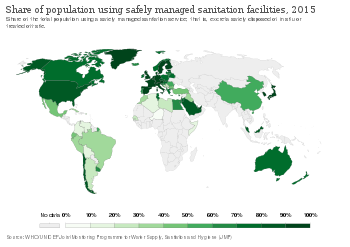Improved sanitation
Improved sanitation is a term used to categorize types or levels of sanitation for monitoring purposes. The term was coined by the Joint Monitoring Program (JMP) for Water Supply and Sanitation of UNICEF and WHO in 2002 to help monitor the progress towards Goal Number 7 of the Millennium Development Goals (MDGs). In 2015 this goal was superceeded by Sustainable Development Goal 6, in which Target 2 states: "By 2030, achieve access to adequate and equitable sanitation and hygiene for all and end open defecation, paying special attention to the needs of women and girls and those in vulnerable situations." Indicator 6.2.1 is the Proportion of population using (a) safely managed sanitation services and (b) a hand-washing facility with soap and water.[2]

The opposite of "improved sanitation" has been termed "unimproved sanitation" in the JMP definitions.
The Joint Monitoring Program (JMP) for Water Supply and Sanitation has been publishing updates on the global sanitation situation on an annual basis. For example, in 2015 it was reported that 68% percent of the world's population had access to improved sanitation.[3]
In 2017, JMP defined a new term: "basic sanitation service". This is defined as the use of improved sanitation facilities that are not shared with other households. A lower level of service is now called "limited sanitation service" which refers to use of improved sanitation facilities that are shared between two or more households. A higher level of service is called "safely managed sanitation". This is basic sanitation service where excreta are safely disposed of in situ or transported and treated offsite.[4]
Definitions
Limited, basic and safely managed sanitation
In 2016, JMP defined three new terms:[4]
- "Basic sanitation service". This is defined as the use of improved sanitation facilities that are not shared with other households.
- A lower level of service than basic sanitation is now called "limited sanitation service" which refers to use of improved sanitation facilities that are shared between two or more households.
- A higher level of service than basic sanitation is called "safely managed sanitation". This is basic sanitation service where excreta are safely disposed of in situ or transported and treated offsite.
Improved sanitation
_(6908550969).jpg)
An improved sanitation facility is defined as one that hygienically separates human excreta from human contact.[5] It is not necessarily identical with sustainable sanitation.
To allow for international comparability of estimates for monitoring the Millennium Development Goals (MDGs), the Joint Monitoring Program (JMP) for Water Supply and Sanitation defines "improved" sanitation as the following kind of toilets:[5]
- Flush toilet
- Connection to a piped sewer system
- Connection to a septic system
- Flush / pour-flush to a pit latrine
- Pit latrine with slab
- Ventilated improved pit latrine (abbreviated as VIP latrine)
- Composting toilet
Unimproved sanitation
.jpg)
Sanitation facilities that are not considered as "improved" (also called "unimproved") are:
- Public or shared latrine (meaning a toilet that is used by more than one household)
- Flush/pour flush to elsewhere (not into a pit, septic tank, or sewer)
- Pit latrine without slab
- Bucket latrines
- Hanging toilet / latrine
- No facilities / bush / field (open defecation)
Whilst "shared" toilets are not counted as improved sanitation, data about usage of shared toilets is nevertheless report in the annual progress reports of the JMP.[6]
References
- Ritchie, Roser, Mispy, Ortiz-Ospina (2018) "Measuring progress towards the Sustainable Development Goals." (SDG 6) SDG-Tracker.org, website
- Ritchie, Roser, Mispy, Ortiz-Ospina (2018) "Measuring progress towards the Sustainable Development Goals." (SDG 6) SDG-Tracker.org, website
- Progress on drinking water and sanitation, 2015 Update. WHO/UNICEF Joint Monitoring Programme for Water Supply and Sanitation (JMP). 2014. ISBN 9789241507240.
- Progress on Drinking Water, Sanitation and Hygiene: 2017 Update and SDG Baselines. Joint Monitoring Programme for Water Supply and Sanitation (JMP), Geneva: World Health Organization (WHO) and the United Nations Children’s Fund (UNICEF). 2017. ISBN 978 92 4 151289 3.
- WHO and UNICEF (2012) Improved and unimproved water and sanitation facilities Archived 2015-10-03 at the Wayback Machine, WHO, Geneva and UNICEF, New York, accessed on 15 June 2015
- WHO and UNICEF Progress on Sanitation and Drinking-water: 2015 Update, WHO, Geneva and UNICEF, New York